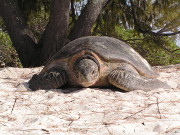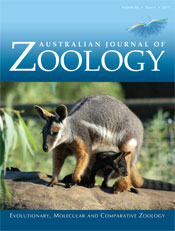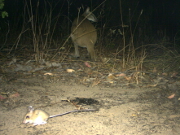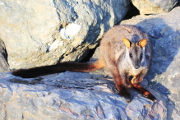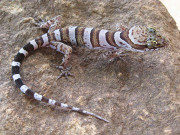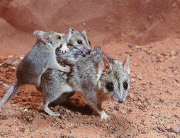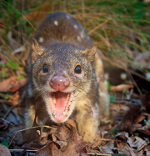Australian Journal of Zoology
Volume 63
Number 6 2015
Within Port Curtis, Queensland, Australia, green turtles forage in two distinct habitats: mangrove estuaries dominated by red algae and seagrass meadows dominated by seagrass. Stable isotope analysis indicates that green turtles regularly switch between these two habitat types.
Photo by David Booth.
Using the most effective camera trap methods is important for the detection of cryptic, threatened species. We tested the attractiveness of four baits to the northern hopping-mouse, northern quoll, northern brown bandicoot and agile wallaby and discuss an improved method for camera trapping quolls which allows consistent recognition of individuals.
Photo by Rebecca Diete.
Reintroduction of brush-tailed rock-wallabies (BTRW) into the Grampians National Park (2008 to 2012) is reviewed. The major cause of mortality was fox predation. Data indicated that predation risk was significantly reduced in releases of fewer animals, declined across time and that disturbing BTRW social structure through the introduction of new animals increased predation risk.
Photo by Iain Stych.
We investigate the historical biogeography of north Queensland’s Cyrtodactylus (ring-tailed) geckos, which have undergone a habitat switch during their evolution. Mitochondrial DNA analyses reveal two major lineages which differ in their distribution and divergence times, most likely due to differences in regional habitat continuity and climate variability.
Photo by Patrick Couper.
Aspects of the reproductive biology of the small dasyurid marsupial, Sminthopsis douglasi, have been studied in captivity and in wild populations. A detailed description of the methods used to house, maintain and assess the reproductive condition of these dunnarts in captivity is provided.
Photo by P. A. Woolley and D. Walsh.
GPS collars revealed that male spotted-tailed quolls used home ranges three times larger than females and also travelled about twice the distance per day. Both sexes appear to maintain exclusive core areas. While quolls were predominantly nocturnal throughout the year, some individuals showed pronounced daytime activity.
Photo by Gerhard Körtner.
